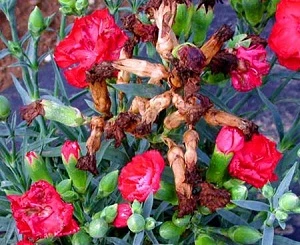

Botrytis flower blight on dianthus. Photo: Cheryl Smith, Univ. of New Hampshire
Nursery and greenhouse growers have been challenged by recent cloudy and rainy weather to produce perennials and keep away Botrytis. Remembering cultural practices and correct fungicides will help until we get more sunshine.
The recent cool, dark, wet weather conditions along with perennials being in full flower in area poly houses and greenhouses can lead to Botrytis blight outbreaks. Crops like coreopsis, dianthus, heuchera, lavandul and rudbeckia can be especially vulnerable to this disease since they have a full flower canopy at this time.
Remember that botrytis is a fungus that can cause leaf spots, petiole blighting and stem cankers on many different annuals and perennials. It will produce large masses of spores that are most often called “grey mold.” These spores or conidia will be spread on wind currents and can travel from infected to uninfected plants in that manner. The spores can live for upwards of 21 to 24 days before they germinate on a plant.
Michigan State University Extension suggests these cultural control practices that will reduce the conditions that favor Botrytis infections, including: reducing the relative humidity in the greenhouse or poly house below 85 percent; making sure plants do not remain wet for six or more hours in a 24-hour period; and if possible, heat and vent mornings and evenings for at least a half-hour or more to reduce humidity and keep plant surfaces dry.
If plants are infected and need to be removed from the growing area, do not just remove the plants and throw them on the compost pile out back as the spores can blow back into the facilities on wind currents. Bag up plants where they were growing, seal the bags and remove them from the facilities.
Click here to read the rest of the article.
Latest from Greenhouse Management
- This month's Greenhouse Management magazine is about native plants and sustainability
- The HC Companies, Classic Home & Garden merge as Growscape
- Terra Nova releases new echinacea variety, 'Fringe Festival'
- Eason Horticultural Resources will now officially be known as EHR
- BioWorks receives EPA approval for new biological insecticide for thrips, aphids, whiteflies
- ScottsMiracle-Gro transfers cannabis subsidiary to focus on core lawn and garden business
- Should we start calling natives 'eco-beneficial plants'?
- Ellen Mackenbach-Lakeman appointed new CEO of Dümmen Orange





